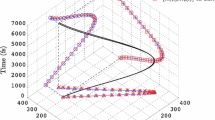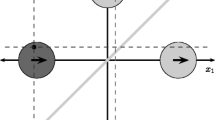Abstract
Much of the the discussion of the metaphysics of quantum mechanics focusses on the status of wavefunctions. This paper is about how to think about wavefunctions, when we bear in mind that quantum mechanics—that is, the nonrelativistic quantum theory of systems of a fixed, finite number of degrees of freedom—is not a fundamental theory, but arises, in a certain approximation, valid in a limited regime, from a relativistic quantum field theory. We will explicitly show how the wavefunctions of quantum mechanics, and the configuration spaces on which they are defined, are constructed from a relativistic quantum field theory. Two lessons will be drawn from this. The first is that configuration spaces are not fundamental, but rather are derivative of structures defined on ordinary spacetime. The second is that wavefunctions are not as much like classical fields as might first appear, in that, on the most natural way of constructing wavefunctions from quantum field-theoretic quantities, the value assigned to a point in configuration space is not a local fact about that point, but rather, depends on the global state.
Similar content being viewed by others
Notes
At least, on a quantum state monist approach. This does not preclude a Bohmian version of quantum field theory in which particles are added to the ontology.
In the context of a relativistic theory, this story needs to be qualified with talk of approximate localization of a particle in \(R\) and the single-particle wavefunction being close to zero in the second state, but the conceptual point remains. See Sect. 4.2.1.
Since one can believe in the reality of wavefunctions without accepting the other two conjuncts, the name is misleading. At a recent workshop on Spacetime and the Wavefunction (Barcelona May 21–22 2014), Nino Zanghì suggested configuration space fundamentalism as a less misleading alternative.
As does Bell, in his well-known remark,“Either the wavefunction, as given by the Schrödinger equation, is not everything, or it is not right” (1987, p. 201).
And it is the need for a choice of an association of operators with dynamical variables that makes it possible to have two common pictures of state evolution. On one—the Schrödinger picture—we keep fixed the association of operators with physical degrees of freedom, and depict a change of physical state via a change in state vector. On the other, the Heisenberg picture, we keep fixed the Hilbert-space vector that represents the state, and change the operator associated with a physical degree of freedom. Both of these depict a changing physical state.
Strictly speaking, these are operator-valued distributions, which yield operators when smeared with appropriate test functions. But it is common, in the physics literature, and especially in textbooks, to call them field operators, and we will adopt this parlance. One should bear in mind, however, that \(|\mathbf {x,t}\rangle \), as defined by (25), is not a vector in our Hilbert space, though, for any square-integrable function \(f\),
$$\begin{aligned} \int d^{3} \mathbf {x} \; f(\mathbf {x}) |\mathbf {x},t\rangle \end{aligned}$$is. We can think of \(|\mathbf {x},t\rangle \) as a mapping from functions \(f\) to Hilbert space vectors.
Talk of local algebras will lead the reader to suspect, correctly, that the author has sympathy with the formulations of quantum theory favored by mathematical physicists, such as e.g. Streater and Wightman (2000); Haag (1996). It should not be inferred that there is any tension with standard textbook treatments; what has been called Axiomatic Quantum Field Theory is an attempt to put the standard theory on a sound mathematical basis, and the so-called axioms are intended to be precise formulations of assumptions made, implicitly or explicitly, in the usual treatments.
(In particular, in this article there is no assumption being made that the theory is well-defined at arbitrarily high energies and at arbitrarily small distance scales. If the spacetime on which the theory is formulated is discrete or ill-defined at the Planck scale, then take what is said to be an approximation valid when dealing with distances large compared to this scale.)
If you don’t know what this means, see the early chapters of almost any introductory quantum field theory text; one textbook that begins with nonrelativistic field theory is Greiner and Reinhardt (1996).
We write this with a discrete index. But treating cases, such as the case of zero potential, in which we have a continuum of energy eigenvalues, proceeds analogously; in the next section we will consider the relativistic field with no external potential.
Note that, since we started with a single, non-self-interacting field, subject only to external potentials, the potential energy for two particles is additive and contains no interaction term. If we had started with the classical theory of two or more interacting fields, we would have obtained creation operators for quanta of each of these fields, and the wavefunction corresponding to a state containing one of each type of field quanta would contain an interaction term.
Not that counterintuitiveness would necessarily be objectionable!
The colons \(\mathbf {:} \; \mathbf {:}\) indicate normal, or Wick ordering, in which annihilation operators \(\hat{a}(\mathbf {k})\), \(\hat{b}(\mathbf {k})\) occur to the right of creation operators \(\hat{a}^{\dag }(\mathbf {k})\), \(\hat{b}^{\dag }(\mathbf {k})\).
To get a sense of the magnitude of Compton wavelengths, for an electron the Compton wavelength is about 1/137th of the Bohr radius of the Hydrogen atom, and for a proton, it is smaller by a factor of 18 million.
For those who care, the quantity
$$\begin{aligned} D(\mathbf {x} - \mathbf {x}') = \langle \mathbf {x}', t|\mathbf {x},t\rangle \end{aligned}$$can be calculated explicitly, and is given by
$$\begin{aligned} D(\mathbf {x} - \mathbf {x}') = \frac{\mu }{ 4 \pi ^{2} r} K_{1}(\mu r), \end{aligned}$$where \(K_{1}\) is a modified Bessel function of the second kind, and \(r = |\mathbf {x} - \mathbf {x}'|\). See Weinberg (1995, p. 202).
Note that we did not take a counterfactual limit, such as \(c \rightarrow \infty \), of the sort that worries philosophers, nor did we consider any idealization. We employed approximations valid for certain regimes.
See the first section of Jackiw (1990) for an introduction to this unfamiliar representation of quantum field-theoretical states.
See Wald (1994) for the classic overview.
References
Albert, D. Z. (1996). Elementary quantum metaphysics. In J. T. Cushing, A. Fine, & S. Goldstein (Eds.), Bohmian mechanics and quantum mechanics: An appraisal (pp. 277–284). Dordrecht: Kluwer.
Albert, D. Z. (2013). Wave function realism. See Ney and Albert, 2013, 52–57.
Bell, J. S. (1987). Are there quantum jumps? In C. Kilmister (Ed.), Schrödinger: Centenary celebration of a polymath (pp. 41–52). Cambridge: Cambridge University Press. Reprinted in Speakable and unspeakable in quantum mechanics (Cambridge University Press, 1987), pp. 201–212.
Busch, P. A. (1999). Unsharp localization and causality in relativistic quantum theory. Journal of Physics A, 32, 6535–6546.
Corichi, A., Cortez, J., & Quevedoa, H. (2004). Schrödinger and Fock representation for a field theory on curved spacetime. Annals of Physics, 313, 446–478.
Fleming, G., & Butterfield, J. (2000). Strange positions. In J. Butterfield & C. Pagonis (Eds.), From physics to philosophy (pp. 108–165). Cambridge: Cambridge University Press.
Fraser, D. (2008). The fate of ‘particles’ in quantum field theories with interactions. Studies in History and Philosophy of Modern Physics, 39, 841–859.
Greiner, W., & Reinhardt, J. (1996). Field quantization. Berlin: Springer.
Haag, R. (1996). Local quantum physics: Fields, particles, algebras (2nd ed.). Berlin: Springer.
Halvorson, H. (2001). Reeh–Schlieder defeats Newton–Wigner: On alternative localization schemes in relativistic quantum field theory. Philosophy of Science, 68, 111–133.
Halvorson, H., & Clifton, R. (2002). No place for particles in relativistic quantum theories? Philosophy of Science, 69, 1–28.
Jackiw, R. (1990). Analysis on infinite-dimensional manifolds—-Schrödinger representation for quantized fields. In O. J. P. Éboli, M. Gomes, & A. Santoro (Eds.), Field Theory and particle physics (pp. 78–143). Singapore: World Scientific.
Lewis, P. J. (2004). Life in configuration space. The British Journal for the Philosophy of Science, 55, 713–729.
Loewer, B. (1996). Humean supervenience. Philosophical Topics, 24, 101–127.
Malament, D. B. (1996). In defense of dogma: Why there cannot be a relativistic quantum mechanics of (localizable) particles. In R. Clifton (Ed.), Perspectives on qauntum reality: Non-relativistic, relativistic, and field-theoretic (pp. 1–10). Dordrecht: Kluwer Academic Publishers.
Maudlin, T. (2010). Can the world be only wavefunction? In S. Saunders, J. Barrett, A. Kent, & D. Wallace (Eds.), Many worlds? Everett, quantum theory, and reality (pp. 121–143). Oxford: Oxford University Press.
Myrvold, W. C. (2003). Relativistic quantum becoming. The British Journal for the Philosophy of Science, 53, 475–500.
Myrvold, W. C. (2011). Nonseparability, classical and quantum. The British Journal for the Philosophy of Science, 62, 417–432.
Ney, A. (2012). The status of our ordinary three dimensions in a quantum universe. Noûs, 46, 525–560.
Ney, A. (2013a). Introduction. See Ney and Albert, 2013a, 1–51.
Ney, A. (2013b). Ontological reduction and the wave function ontology. See Ney and Albert, 2013b, 168–183.
Ney, A., & Albert, D. Z. (Eds.). (2013). The Wave Function: Essays on the Metaphysics of Quantum Mechanics. Oxford: Oxford University Press.
Norsen, T. (2005). Einstein’s boxes. American Journal of Physics, 73, 164–176.
North, J. (2013). The structure of a quantum world. See Ney and Albert, 2013, 184–202.
Norton, J. D. (2011). Little boxes: A simple implementation of the Greenberger, Horne, and Zeilinger result for spatial degrees of freedom. American Journal of Physics, 79, 182–188.
Ryder, L. H. (1996). Quantum field theory (2nd ed.). Cambridge: Cambridge University Press.
Streater, R. F., & Wightman, A. S. (2000). PCT, spin and statistics, and all that. Princeton: Princeton University Press.
Wald, R. M. (1994). Quantum field theory in curved spacetime and black hole thermodynamics. Chicago: University of Chicago Press.
Wallace, D., & Timpson, C. G. (2010). Quantum mechanics on spacetime I: Spacetime state realism. The British Journal for the Philosophy of Science, 61, 697–727.
Weinberg, S. (1995). The quantum theory of fields (Vol. I). Cambridge: Cambridge University Press.
Acknowledgments
I would like to thank David Albert, Erik Curiel, Sheldon Goldstein, Carl Hoefer, Douglas Kutach, Joshua Luczak, Kerry McKenzie, Tim Maudlin, Vishnya Maudlin, Alyssa Ney, Travis Norsen, Albert Solé, Roderich Tumulka. and Nino Zanghì for helpful discussions and comments, as well as members of the audience at the Southwestern Ontario Philosophy of Physics colloquium, at PSA 2012, and at the Second PERSP Workshop on Space-Time and the Wave Function, Barcelona 2014. This work was supported by a grant from the Foundational Questions Institute (FQXi).
Author information
Authors and Affiliations
Corresponding author
Rights and permissions
About this article
Cite this article
Myrvold, W.C. What is a wavefunction?. Synthese 192, 3247–3274 (2015). https://doi.org/10.1007/s11229-014-0635-7
Received:
Accepted:
Published:
Issue Date:
DOI: https://doi.org/10.1007/s11229-014-0635-7




